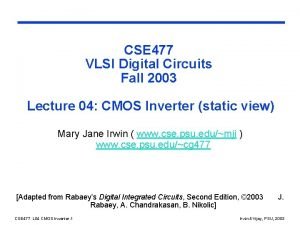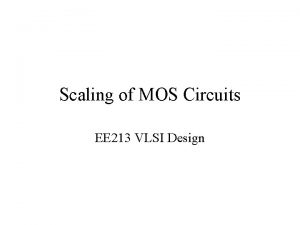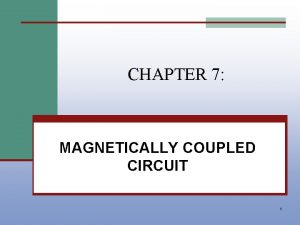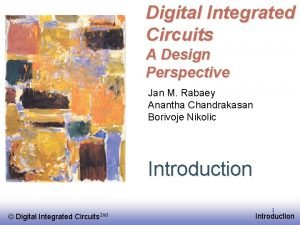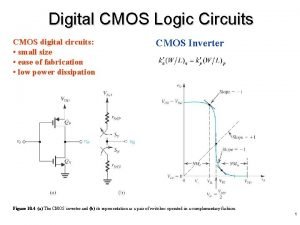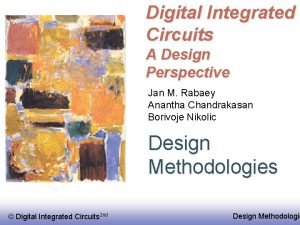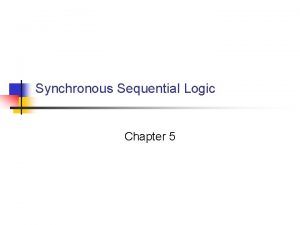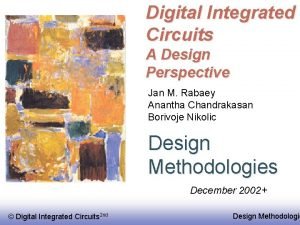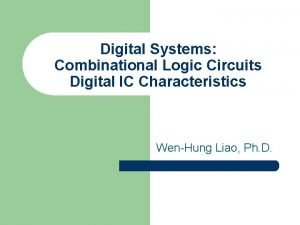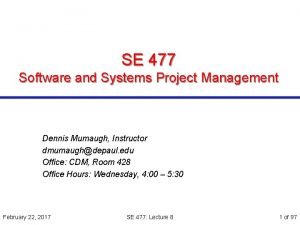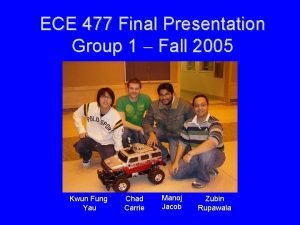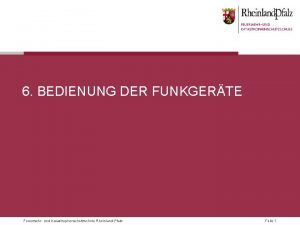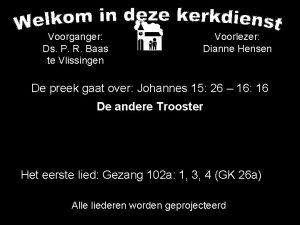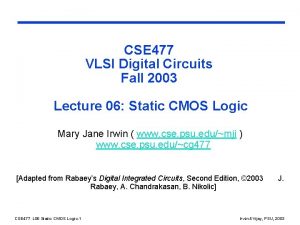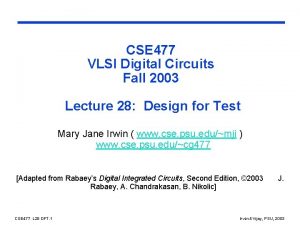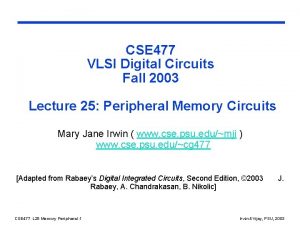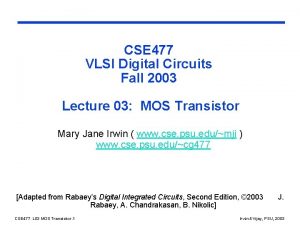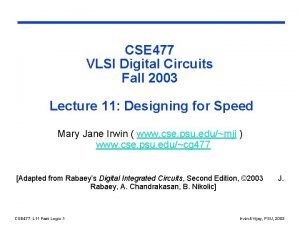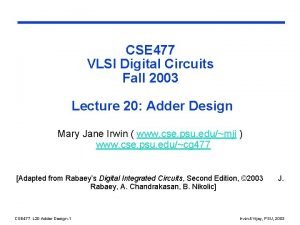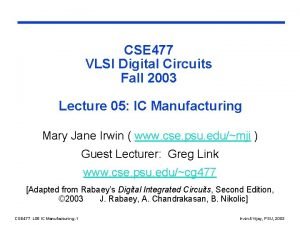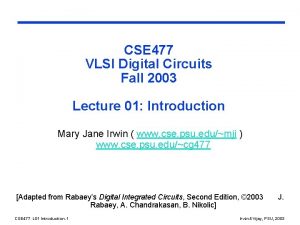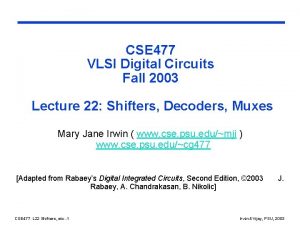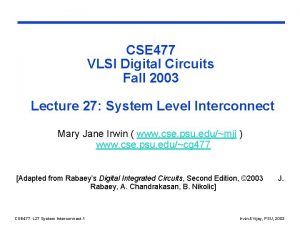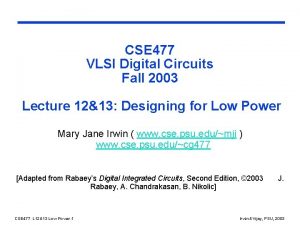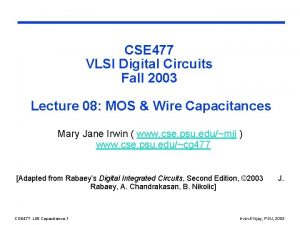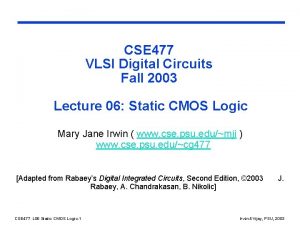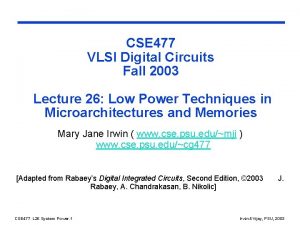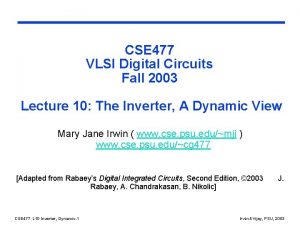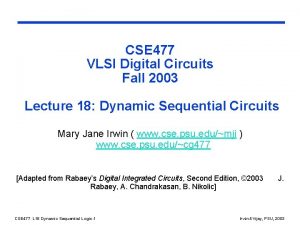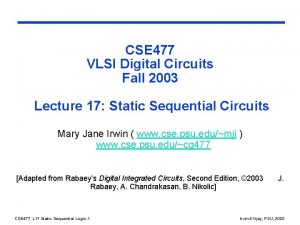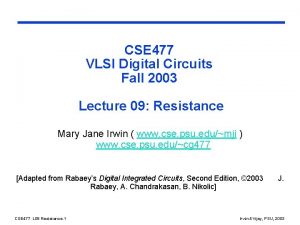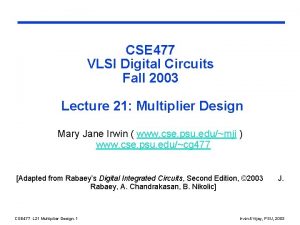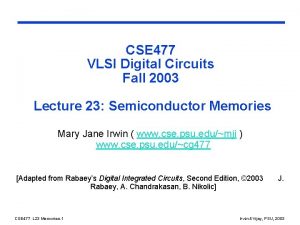CSE 477 VLSI Digital Circuits Fall 2003 Lecture























- Slides: 23

CSE 477 VLSI Digital Circuits Fall 2003 Lecture 04: CMOS Inverter (static view) Mary Jane Irwin ( www. cse. psu. edu/~mji ) www. cse. psu. edu/~cg 477 [Adapted from Rabaey’s Digital Integrated Circuits, Second Edition, © 2003 Rabaey, A. Chandrakasan, B. Nikolic] CSE 477 L 04 CMOS Inverter. 1 J. Irwin&Vijay, PSU, 2003

Review: Design Abstraction Levels SYSTEM MODULE + GATE CIRCUIT Vin Vout G S n+ CSE 477 L 04 CMOS Inverter. 2 DEVICE D n+ Irwin&Vijay, PSU, 2003

Review: The MOS Transistor Gate oxide Polysilicon W Gate Source n+ L Drain n+ Field-Oxide (Si. O 2) p substrate p+ stopper Bulk (Body) CSE 477 L 04 CMOS Inverter. 3 Irwin&Vijay, PSU, 2003

CMOS Inverter: A First Look VDD Vin Vout CL CSE 477 L 04 CMOS Inverter. 4 Irwin&Vijay, PSU, 2003

CMOS Inverter: Steady State Response VDD VOL = 0 VOH = VDD VM = f(Rn, Rp) Rp Vout = 1 Vout = 0 Rn Vin = 0 CSE 477 L 04 CMOS Inverter. 5 Vin = V DD Irwin&Vijay, PSU, 2003

CMOS Properties q Full rail-to-rail swing high noise margins l Logic levels not dependent upon the relative device sizes transistors can be minimum size ratioless q Always a path to Vdd or GND in steady state low output impedance (output resistance in k range) large fan-out (albeit with degraded performance) q Extremely high input resistance (gate of MOS transistor is near perfect insulator) nearly zero steady-state input current q No direct path steady-state between power and ground no static power dissipation q Propagation delay function of load capacitance and resistance of transistors CSE 477 L 04 CMOS Inverter. 6 Irwin&Vijay, PSU, 2003

Review: Short Channel I-V Plot (NMOS) X 10 -4 ID (A) VGS = 2. 0 V VGS = 1. 5 V VGS = 1. 0 V Linear dependence VGS = 2. 5 V VDS (V) NMOS transistor, 0. 25 um, Ld = 0. 25 um, W/L = 1. 5, VDD = 2. 5 V, VT = 0. 4 V CSE 477 L 04 CMOS Inverter. 7 Irwin&Vijay, PSU, 2003

Review: Short Channel I-V Plot (PMOS) l All polarities of all voltages and currents are reversed VDS (V) VGS = -1. 5 V ID (A) VGS = -1. 0 V VGS = -2. 5 V X 10 -4 PMOS transistor, 0. 25 um, Ld = 0. 25 um, W/L = 1. 5, VDD = 2. 5 V, VT = -0. 4 V CSE 477 L 04 CMOS Inverter. 8 Irwin&Vijay, PSU, 2003

Transforming PMOS I-V Lines l Want common coordinate set Vin, Vout, and IDn IDSp = -IDSn VGSn = Vin ; VGSp = Vin - VDD VDSn = Vout ; VDSp = Vout - VDD IDn Vout Vin = 0 Vin = 1. 5 VGSp = -1 VGSp = -2. 5 CSE 477 L 04 CMOS Inverter. 9 Mirror around x-axis Vin = VDD + VGSp IDn = -IDp Horiz. shift over VDD Vout = VDD + VDSp Irwin&Vijay, PSU, 2003

CMOS Inverter Load Lines IDn (A) PMOS NMOS X 10 -4 Vin = 0 V Vin = 2. 5 V Vin = 0. 5 V Vin = 2. 0 V Vin = 1. 0 V Vin = 2 V Vin = 1. 5 V Vin = 0. 5 V Vin = 1. 0 V Vin = 2. 0 V Vin = 0. 5 V Vin = 0 V Vin = 2. 5 V Vout (V) 0. 25 um, W/Ln = 1. 5, W/Lp = 4. 5, VDD = 2. 5 V, VTn = 0. 4 V, VTp = -0. 4 V CSE 477 L 04 CMOS Inverter. 10 Irwin&Vijay, PSU, 2003

CMOS Inverter VTC NMOS off PMOS linear Vout (V) NMOS sat PMOS linear NMOS sat PMOS sat NMOS linear PMOS sat PMOS off Vin (V) CSE 477 L 04 CMOS Inverter. 12 Irwin&Vijay, PSU, 2003

CMOS Inverter: Switch Model of Dynamic Behavior VDD Rp Vout CL Vin = 0 CL Rn Vin = V DD l Gate response time is determined by the time to charge CL through Rp (discharge CL through Rn) CSE 477 L 04 CMOS Inverter. 14 Irwin&Vijay, PSU, 2003

Relative Transistor Sizing q When designing static CMOS circuits, balance the driving strengths of the transistors by making the PMOS section wider than the NMOS section to l maximize the noise margins and l obtain symmetrical characteristics CSE 477 L 04 CMOS Inverter. 15 Irwin&Vijay, PSU, 2003

Switching Threshold q VM where Vin = Vout (both PMOS and NMOS in saturation since VDS = VGS) VM r. VDD/(1 + r) where r = kp. VDSATp/kn. VDSATn q Switching threshold set by the ratio r, which compares the relative driving strengths of the PMOS and NMOS transistors q Want VM = VDD/2 (to have comparable high and low noise margins), so want r 1 (W/L)p (W/L)n = CSE 477 L 04 CMOS Inverter. 16 kn’VDSATn(VM-VTn-VDSATn/2) kp’VDSATp(VDD-VM+VTp+VDSATp/2) Irwin&Vijay, PSU, 2003

Switch Threshold Example q In our generic 0. 25 micron CMOS process, using the process parameters from slide L 03. 26, a VDD = 2. 5 V, and a 1. 5 size NMOS device (W/L)n NMOS PMOS VT 0(V) 0. 43 -0. 4 (V 0. 5) 0. 4 -0. 4 VDSAT(V) 0. 63 -1 (V-1) 0. 06 -0. 1 k’(A/V 2) 115 x 10 -6 -30 x 10 -6 (W/L)p 115 x 10 -6 0. 63 (1. 25 – 0. 43 – 0. 63/2) (W/L)n = -30 x x 10 -6 -1. 0 x (1. 25 – 0. 4 – 1. 0/2) = 3. 5 (W/L)p = 3. 5 x 1. 5 = 5. 25 for a VM of 1. 25 V CSE 477 L 04 CMOS Inverter. 18 Irwin&Vijay, PSU, 2003

Simulated Inverter VM VM is relatively insensitive to variations in device ratio q setting the ratio to 3, 2. 5 and 2 gives VM’s of 1. 22 V, 1. 18 V, and 1. 13 V VM (V) l Increasing the width of the PMOS moves VM towards VDD q ~3. 4 . 1 (W/L)p/(W/L)n Note: x-axis is semilog CSE 477 L 04 CMOS Inverter. 19 Increasing the width of the NMOS moves VM toward GND q Irwin&Vijay, PSU, 2003

Noise Margins Determining VIH and VIL By definition, VIH and VIL are where d. Vout/d. Vin = -1 (= gain) VOH = VDD Vout NMH = VDD - VIH NML = VIL - GND VM VOL = GND Vin A piece-wise linear approximation of VTC CSE 477 L 04 CMOS Inverter. 20 Approximating: VIH = VM - VM /g VIL = VM + (VDD - VM )/g So high gain in the transition region is very desirable Irwin&Vijay, PSU, 2003

CMOS Inverter VTC from Simulation 0. 25 um, (W/L)p/(W/L)n = 3. 4 (W/L)n = 1. 5 (min size) VDD = 2. 5 V Vout (V) VM 1. 25 V, g = -27. 5 VIL = 1. 2 V, VIH = 1. 3 V NML = NMH = 1. 2 (actual values are VIL = 1. 03 V, VIH = 1. 45 V NML = 1. 03 V & NMH = 1. 05 V) Vin (V) CSE 477 L 04 CMOS Inverter. 21 Output resistance low-output = 2. 4 k high-output = 3. 3 k Irwin&Vijay, PSU, 2003

Gain Determinates gain Vin Gain is a strong function of the slopes of the currents in the saturation region, for Vin = VM (1+r) g -----------------(VM-VTn-VDSATn/2)( n - p ) Determined by technology parameters, especially channel length modulation ( ). Only designer influence through supply voltage and VM (transistor sizing). CSE 477 L 04 CMOS Inverter. 22 Irwin&Vijay, PSU, 2003

Impact of Process Variation on VTC Curve Vout (V) Good PMOS Bad NMOS Nominal Bad PMOS Good NMOS Vin (V) l Process variations (mostly) cause a shift in the switching threshold CSE 477 L 04 CMOS Inverter. 23 Irwin&Vijay, PSU, 2003

Vout (V) Scaling the Supply Voltage Gain=-1 Vin (V) Device threshold voltages are kept (virtually) constant CSE 477 L 04 CMOS Inverter. 24 Vin (V) Device threshold voltages are kept (virtually) constant Irwin&Vijay, PSU, 2003

Next Time: CMOS Inverter max Layout Out In metal 1 -poly via metal 1 polysilicon metal 2 VDD pdiff PMOS (4/. 24 = 16/1) NMOS (2/. 24 = 8/1) metal 1 -diff via ndiff GND metal 2 -metal 1 via CSE 477 L 04 CMOS Inverter. 25 Irwin&Vijay, PSU, 2003

Next Lecture and Reminders q Next lecture l IC manufacturing - Reading assignment – Rabaey, et al, 2. 1 -2. 3 presented by guest lecturer Greg Link q Reminders l HW 2 due September 30 l Project team and title due September 18 th (next class!) Evening midterm exam scheduled l - Monday, October 20 th , 20: 15 to 22: 15, Location TBD - Please let me know ASAP (via email) if you have a conflict CSE 477 L 04 CMOS Inverter. 26 Irwin&Vijay, PSU, 2003
 Cse477
Cse477 Scaling factors for device parameters in vlsi
Scaling factors for device parameters in vlsi Advantages of parallel circuits over series circuit
Advantages of parallel circuits over series circuit Cmos vlsi design lecture notes
Cmos vlsi design lecture notes Magnetically coupled circuits lecture notes
Magnetically coupled circuits lecture notes Kim ki duk spring summer fall winter
Kim ki duk spring summer fall winter 01:640:244 lecture notes - lecture 15: plat, idah, farad
01:640:244 lecture notes - lecture 15: plat, idah, farad Digital integrated circuits a design perspective
Digital integrated circuits a design perspective Digital integrated circuits: a design perspective
Digital integrated circuits: a design perspective Digital circuits
Digital circuits Troubleshooting digital circuits
Troubleshooting digital circuits Digital integrated circuits a design perspective
Digital integrated circuits a design perspective State diagram
State diagram Digital integrated circuits
Digital integrated circuits Signal circuit
Signal circuit Characteristics of digital ic
Characteristics of digital ic Sw 477
Sw 477 1+3 3 log 50
1+3 3 log 50 Sr0fx
Sr0fx Sepura *477
Sepura *477 Biba n 483 ddl
Biba n 483 ddl Experiment 484
Experiment 484 Liedboek 477
Liedboek 477 Ece 477
Ece 477
